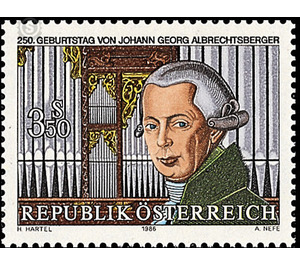250th birthday - Austria / II. Republic of Austria 1986 - 3.50 Shilling
Theme: Art & Culture
| Country | Austria / II. Republic of Austria |
| Issue Date | 1986 |
| Face Value | 3.50 |
| Color | multi-colored brown grey |
| Printing Type | combination printing |
| Stamp Type | Commemorative |
| Item Type | Stamp |
| Chronological Issue Number | 1182 |
| Chronological Chapter | OOS-OE2 |
| SID | 832214 |
| In 66 Wishlists | |
Johann Georg Albrechtsberger was born on February 3, 1736 in Klosterneuburg. At the age of 13, he came to the collegiate grammar school in Melk, which he left again in 1753 to take up philosophical studies at the Vienna Jesuit seminary. Here he met Michael Haydn and also had friendly contacts with his famous brother Joseph. From 1755 to 1757 he worked as an organist in Raab and from 1757 to 1759 in the pilgrimage church in Maria Taferl. He then came to Melk, where he worked until 1766 as an organist. In 1772, Emperor Josef II called the 36-year-old man the second court organist. Wolfgang Amadeus Mozart recommended Albrechtsberger, who had meanwhile become the first court organist, as his successor as Kapellmeisteradjunkt in St. Stephan. After the death of Leopold Hofmann he was appointed cathedral conductor of St. Stephen, a position he held until his death on March 7, 1809. 279 church compositions, 278 works for keyboard instruments, 193 secular instrumental works, including 4 symphonies, solo concertos for organ, harp, trombone are only an excerpt from his extensive life's work. However, Albrechtsberger's greatest merit lies in the education of succeeding generations of musicians. He is described as the most important theoretician at the turn of the classic to the romanticism. Among other things, Beethoven was one of his students, who had taken lessons from Joseph Haydn in the previous years and was sent by this to Albrechtsberger to continue his studies. The friendly relationship between Albrechtsberger and Beethoven continued even after his two-year study period.


